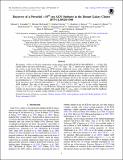Discovery of a Powerful >10 61 erg AGN Outburst in the Distant Galaxy Cluster SPT-CLJ0528-5300
Author(s)
Calzadilla, Michael S; McDonald, Michael A.; Bayliss, Matthew B; Benson, Bradford A; Bleem, Lindsey E; Brodwin, Mark; Edge, Alastair C; Floyd, Benjamin; Gupta, Nikhel; Hlavacek-Larrondo, Julie; McNamara, Brian R; Reichardt, Christian L; ... Show more Show less
DownloadPublished version (1.402Mb)
Publisher Policy
Publisher Policy
Article is made available in accordance with the publisher's policy and may be subject to US copyright law. Please refer to the publisher's site for terms of use.
Terms of use
Metadata
Show full item recordAbstract
© 2019. The American Astronomical Society. All rights reserved. We present ∼103 ks of Chandra observations of the galaxy cluster SPT-CLJ0528-5300 (SPT0528, z = 0.768). This cluster harbors the most radio-loud (L 1.4GHz = 1.01 × 1033 erg s-1 Hz-1) central active galactic nucleus (AGN) of any cluster in the South Pole Telescope (SPT) Sunyaev-Zeldovich survey with available X-ray data. We find evidence of AGN-inflated cavities in the X-ray emission, which are consistent with the orientation of the jet direction revealed by Australia Telescope Compact Array radio data. The combined probability that two such depressions-each at ∼1.4-1.8σ significance, oriented ∼180° apart and aligned with the jet axis-would occur by chance is 0.1%. At ⪆1061 erg, the outburst in SPT0528 is among the most energetic known in the universe, and certainly the most powerful known at z > 0.25. This work demonstrates that such powerful outbursts can be detected even in shallow X-ray exposures out to relatively high redshifts (z ∼ 0.8), providing an avenue for studying the evolution of extreme AGN feedback. The ratio of the cavity power (Pcaw=(9.4 ±5.8)× 1045 erg s-1) to the cooling luminosity (L cool = (1.5 ± 0.5) × 1044 erg s-1) for SPT0528 is among the highest measured to date. If, in the future, additional systems are discovered at similar redshifts with equally high P cav/L cool ratios, it would imply that the feedback/cooling cycle was not as gentle at high redshifts as in the low-redshift universe.
Date issued
2019Department
MIT Kavli Institute for Astrophysics and Space Research; Massachusetts Institute of Technology. Department of PhysicsJournal
Astrophysical Journal Letters
Publisher
American Astronomical Society